Exploring Some Castles- A Medieval Hiatus
8/10-8/15
447.6 km from Canterbury
At this point, I decided to take a few days and do some exploring and sightseeing before I strapped on my hiking boots again. I hadn't realized when I first started my pilgrimage that I wouldn't be seeing that many sights along the route in France that interested me. So, to assuage my nerdy impulses, I decided to travel around a bit to look at some castles and towns. First stop, Soissons!
I tested out BlaBlaCar for the first time on this trip; it's similar to our Uber. People who are planning to drive somewhere will post their itinerary online and how many seats they have available. Then other travelers will ask to join them on their trip, and they decide on a pick-up and drop-off point. It worked quite well and was much cheaper than the train and bus fares. My driver to Soissons was a young French student in her early 20s. She spoke English pretty well, and we talked a little bit about my pilgrimage. She had never heard of the Via Francigena, and she had lived in the Lorraine region her whole life! It just goes to show you that the Via Francigena is still quite a fledgling route-- especially here in France. She dropped me off at the Soissons municipal campsite, and I set up my tent before walking into town.
I had planned to visit the fortress Château de Septmonts today (which is several kilometers out of town) as well as several of the city's religious buildings and ruins. This is where I ran into the first of my problems in France in August. I had heard that August was a holiday month and had even had issues before with businesses being closed for the whole month, but here I found out that the transportation system also takes a break in August. The only way to get to Septmonts at this time was a bus that I had to call and make a reservation for both directions. Luckily the woman on the phone spoke a good mix of English and French, and we were able to make a reservation for that afternoon. I wanted several hours at the castle knowing myself and how I can easily become lost in my own mind when exploring an interesting site, but until I left, I explored Soissons.
There was a delightful little Romanesque church that faced the cathedral's east end across the main square.
The cathedral itself was very large and grand but spare of much carving ornamentation. It was quite the contrast to the heavily decorated cathedrals at Laon and Reims with its clean pointed arches and tympanum.
When the time came for my bus to Septmonts, I met it in front of the little Romanesque church. I had the whole bus to myself on the 10-minute ride to the neighboring town. When I got out and beheld Septmonts for the first time I was in awe.
This château was the coolest thing I had ever seen. It sprouted up from the ground like a fairytale castle that had been mixed with a fortress– a tall and thin spire of stone erupting from the grass below.
The remainders of the walls and grounds surrounding it were clearly in worse repair than the keep itself. I walked to where it said "entrance" on some glass doors though when I peeked in it was an empty room. Bewildered I walked around and found the entrance to the keep open and empty. No one else was there except for me.
 |
| A little gnome's tower |
I liked this sculpture
|
 |
| I also love ruined staircases |
The keep is open to the public and free. I entered not knowing what to expect as I had not heard of the castle before looking into places around Reims. The inside of the keep looked like an empty white shell. Everything unique and distinguishable gone that had ever been put inside. The walls and floor looked like white chalk but was made of limestone.
 |
| Empty white corridors |
One spiral staircase was the only means of moving between floors
|
As I climbed the spiral staircase (it really was Rapunzel's tower!) I was amazed by how empty it all seemed- devoid of humanity's touch for so long.
|
Each floor had it's own fireplace
|
The walls were covered in the careless scrawls and signatures of wayward teenagers wanting to leave a mark of their existence while defying the law at the same time. Shaking my head I was sad at the plight of the keep.
But then, as I climbed higher, I started noticing the markings of neater hands, some darkened with age. I paid more and more attention to the walls and began seeing dates. I hadn't known much about the history of the castle other than it was built as a bishop's residence and had been bombed in WWI. Now I saw that there were so many signatures of people, travelers, and soldiers who wanted to leave their mark on the world just like those wayward teenagers.
I found signatures from 1780, 1830, 1914, 1945, and 1960. I wondered if the German army might have held the castle at some point, there were many German names from 1914-1918. Several notes told a brief description as well as the name and date.
One signature I found was beneath a plastic protective cover hidden behind a door (by that time I was scouring the walls moving at a snail's pace up the tower). I took a picture even though it was hard to make out; I just figured it must have been an important one. I later found out it was Victor Hugo's signature from when he visited the keep in 1835!
A few people visited and quickly climbed up and down the keep paying no mind to the graffiti on the walls while I was there but overall I had the place to myself. I spent 2 hours in that empty shell of a castle just looking at people signatures and imagining their place in history. It was a fantastic experience.
Here I added tons of pictures of signatures I saw. I found these incredibly exciting and fascinating, but I understand if they are not your jam so feel free to scroll wildly down to the next section, otherwise enjoy!! There were some areas of wall that were layers and layers of scrolls made on top and next to each other over the years.
 |
| Roof and doorways apparent from the outside |
 |
| I spy the top finally! |
After walking back down, I briefly explored the grounds around the keep.
 |
| Arboretum around the castle |
 |
| Family playing ball in the courtyard |
Garden sculptures
|
My future home
|
I caught my private bus back to Soissons two hours later and did some more exploring about town. A glorious find was the ruin of the Abbaye Saint-Jean-des-Vignes. Unfortunately, the site was closed so I didn't have a chance to explore inside but it's steeples towered over the city making it look very much like a taller, grander and more ornamental version of the cathedral itself.
The next day I planned to visit the Château de Coucy. I had read Barbara Tuchman's A Distant Mirror about the 14th-century lords of Coucy years ago and had no idea that Coucy was so close to where I was walking, so when I found out I had to visit! Alas, the bus that ran from Soissons to Château de Coucy all year long also took a hiatus during August. I briefly considered walking there, but since I was already walking half of Europe, I decided to bike there with the bike from my campsite.
Big mistake! As a little bit of background, I hate biking with a passion, bikes and I have never coexisted peacefully together. I remember family outings on mountain bike trails with palpable distaste and unhappy memories of my parents thinking I was being sullen and uncooperative. No no no, biking has always been my nemesis– But for the sake of not spending a minor fortune on a taxi, I decided I would suck it up and bike.
Big mistake! As a little bit of background, I hate biking with a passion, bikes and I have never coexisted peacefully together. I remember family outings on mountain bike trails with palpable distaste and unhappy memories of my parents thinking I was being sullen and uncooperative. No no no, biking has always been my nemesis– But for the sake of not spending a minor fortune on a taxi, I decided I would suck it up and bike.
Château de Coucy was only 18 km from Soissons and should have taken me around 2 hours each way. The bike trip was awful as was expected, it was incredibly hard to pedal, and I felt like I was going uphill the whole way. I took the shortest route which was along the highway. This was a huge mistake, and as I felt Death whip it's way past me I feebly pedaled faster, trying to escape its wheels.
Finally, I reached the valley below the château and walked my bike to the top. At the ramparts, I stopped and had a picnic overlooking the baby vineyards sprawling over the slope.
By the time I entered the castle grounds, it had started drizzling. Additionally, the museum was closed for the month of August– naturally– and the bathrooms as well. I walked into the center square and found to my growing dismay that the tourist office was also closed for August. The only tabac I saw was also closed.
The town was deserted and with a growing sense of defeat combined with the strong need for a bathroom drove me to the château which by this point I also expected to be closed. By some stroke of luck it was open, and though there were no English tours, I was able to get a ticket and enter. I had arrived, and even though the day had not been entirely pleasant, I was excited to see the setting for Tuchman's book finally.
 |
| Château de Coucy in it's heyday |
The Château de Coucy first was built in 920, but it reached its grandest form under the rule of Enguerrand III in 1220 who enclosed the town within the walls and built the keep, and Enguerrand VII who built a sumptuous renaissance palace in the late 14th century. The keep was 54 meters tall, twice the size of the French royal keep in the Louvre that was made during the same period. This showed the relative power and money of the Dukes of Coucy that they built a château so much bigger and grander than that of even the king of France. Alas, the château would not bask in the light forever and changed hands several times before falling into disrepair. After suffering several hundred years of ruin the château was restored by Viollet-le-Duc and became quite the tourist destination in the 19th and 20th centuries.
Main gate
|
Within the walls was the area that was used by castle servants and workers as their dwelling places. Traces of chimneys, roofs, and doorways can be seen all over the walls.
 |
| Building with a roof and two floors |
The church was a 12th-century Romanesque chapel which served the keep. It is the oldest building still seen in Coucy.
Next, I climbed into one of the ruined guard towers, not all of which were safe to go in and explore. I was able to get a beautiful view of the valley below and the ramparts of Coucy.
 |
| Guardroom |
 |
| That big straight road you see... yes I biked that... |
 |
| The keep and renaissance palace |
There was a whole herd of goats chilling in the ruins.
I had known that the castle had been bombed in WWI, but nothing had prepared me for the extent of the destruction. The Germans had occupied the keep from 1914-1917 and before they retreated they put explosives in each tower and destroyed the keep. You could see from the battlements at the top how great a viewpoint the château had all around, and I could imagine how grand it would've looked from the valley with its keep intact!
This was a view of Château de Coucy before the German occupation in WWI.
View of Château de Coucy in 1917 after the Germans retreated.
This pile of rubble is just from the keep!
 |
| The metal bands were used to support the keep |
This section is what was left of the renaissance palace.
 |
| German signatures |
This act of destruction is horrifying when seeing the château in person. I could not believe the extent of the damage! It was incredibly saddening to see such wanton destruction and disregard for historically and culturally significant monuments intrinsic to the identity of Europe. To destroy the castle the Germans had to place explosives in each tower, but the central keep was so big that they had to use 28 tons of explosives just for that single tower! The destruction of Château de Coucy caused such public outrage that the site was never rebuilt but instead conserved as it was as a "memorial to barbarity."
 |
Renaissance palace
|
This large room was called the "Salle des Preux" because of the statues of Worthies that adorned the walls. The nine Preux Worthies appeared in 14th-century literature to illustrate the chivalric virtues of courage and valor. It would have functioned as a ceremonial banquet hall.
In the tour de l'Avoine, there was an oubliette which was the only entrance into the dungeons of the château.
 |
| Oubliette |
In the basement cellars they stored sculptures and other archeological finds.
 |
| Man's torso |
Artifacts room
|
The keep and château
|
Little cute church herb garden
|
The visit to Château de Coucy was both interesting and sobering and horrifying. The damage done by war is well known throughout the world. I have seen many horrific examples of the two world wars already in France but that exposure hasn't quite lessened the disturbing reality at all.
On the bike ride home I decided to ride on a slightly more off-beaten track. I finally realized halfway back to Soissons that my bike was actually broken!! The back brake was broken so that it was always partly engaging! So anytime I was biking on anything other than a moderate downhill it felt like I was going uphill and when I was actually going uphill I had to get off and walk... And walking felt like I was trying to walk a bike with the brakes fully loaded!
Cursing bikes to hell I struggled for several more kilometers until a nice old man stopped his car on the side of the road and offered to help fix my bike. He told me to stay put in his broken English and drove home to get some tools. When he came back, he found that the tools were the wrong size and drove home again! The second time he returned with different tools and tutted over the brake for a few minutes until he fixed it! Thank god for good Samaritans!! I thanked him profusely in broken French and biked the rest of the way back to camp with relative ease!
The next day I planned to take a bus to the imperial city of Compiègne, just northeast of Paris, where I had contacted a young Frenchwoman named Kate on Couchsurfing. This was my first time trying the app, and it was an incredible experience! I will absolutely do it again. Kate and her roommates made me feel at home and comfortable and like I was genuinely experiencing French life for the first time.
But first, the bus to Compiègne was over an hour late- probably because it was August...
But first, the bus to Compiègne was over an hour late- probably because it was August...
 |
| Joan of Arc |
The town hall was a gorgeous confection of flamboyant gothic art and faced a statue of Joan of Arc in the main square. I spied another statue of Joan on the facade to the right of an equestrian statue of King Louis XII.
 |
| Another Joan |
I arrived in Compiègne in the early afternoon and set off to explore until I met up with Kate at her home. I visited the imperial château first. This palace was built for King Louis XV and was restored by Napoleon. Compiègne was one of the three seats of royal government in France and as such boasts a luxurious royal place.
When I arrived with my big backpack, the guards asked me to empty the whole thing for them to see. The whole situation ended up being quite comical as I sheepishly pulled bit by bit out while the guard sheepishly urged me to continue, both of us feeling bad for making the other go through the whole thing. He finally let me in, and the helpful woman at the front desk allowed me to leave my giant bag behind the counter.
The château was everything you would expect from a palace used by Louis XV. It was very similar to Versailles if somewhat smaller.
 |
| Salon |
 |
| Exotic touches |
 |
| I quite liked this chair |
One of the rooms was a game room and held this old pinball-machine-looking device.
This is a map of the forest of Compiègne. The city rests at the northwestern corner of the forest throughout which you can see regular and geometric lines. This forest was a favorite for sport and hunting for the royalty of France until Napoleon. It was also the site of the two armistices between Germany and France, one ending WWI in 1918 with the German's surrender and one during WWII with the surrender of France. Hitler chose the same spot, in the same train carriage, that the WWI armistice occurred in for the French surrender to humiliate France. Unfortunately, this site was out of my way, and I was not able to see it.
Château de Pierrefonds, which I visited the next day is the dark dot in the far East side of the forest below the larger bubble-like clearing-- it's small :) don't feel bad if you don't see it!
 |
| Bedcamber |
 |
| My personal favorite: the study with the walls of books! |
 |
| The queen's meeting room |
 |
| Ballroom |
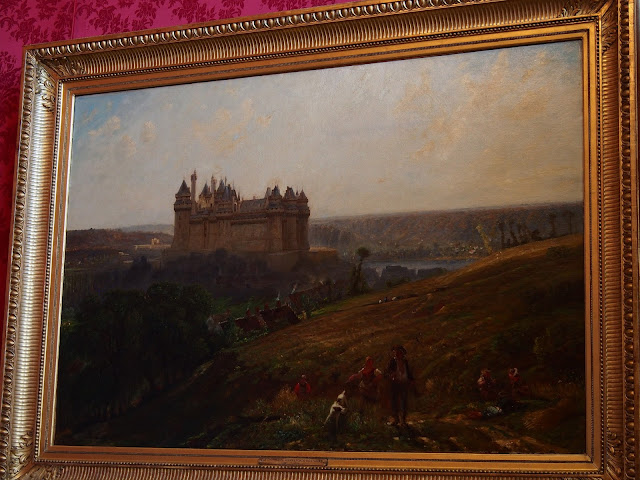 |
| A painting of Château de Pierrefonds |
I walked to Kate's apartment which was just a kilometer outside the city center. She greeted me and immediately I liked her. She was funny, warm and welcoming and spoke excellent English. To my delight, she had also just adopted a kitten (a tiny devilish little munchkin with the ironically butch name of Boris).
 |
| Boris!! |
Kate and I talked for a while, and it was nice having a mare in-depth conversation with a French person around the same age as me. We spoke about misconceptions between cultures, specifically French and Americans. She had to leave for a dinner for a friends birthday that night, but her roommates came home and cooked me an fantastic Chinese dish while we watch The Nice Guys in English and they tried to follow along! Later that night Kate came back, and we talked some more before going to bed.
My plan for the next day was to visit some places in Compiègne before taking a bus to Pierrefonds where there was another amazing château. Kate and her boyfriend then decided to go to Pierrefonds that afternoon and offered me a ride!
 |
| Another Joan of Arc |
 |
| Joan of Arc frees the city of Orlèans |
 |
| Joan of Arc captured at the gates of Compiègne |
 |
| Joan of Arc burning at the stake |
 |
| Saint Antoine– 13th century |
That morning I explored Compiègne. There was a market in the main square where I bought a giant rotisserie chicken and potatoes. I had been craving some warm rich foods after eating so many bland sandwiches.
Afterward, I found the bridge where the Burgundians had captured Joan of Arc, the bridge is hardly even still visible and is now built into a building.
I found this building which I think I read is the oldest standing wooden timbered house in Compiègne. It was a touristy medieval nerd shop which suited me just fine :)
St James Church was incredible. St James (Jacques) is a pilgrim saint, and so this church is significant on one of the pilgrimage routes going to Santiago de Compostela.
 |
| Saint Jacques (St James) 13th-18th century |
When I entered no one else was in the church, and the organist was practicing a haunting tune. It was an ethereal experience walking into the richly decorated interior and sitting down alone to listen to the organ playing. The church's pointed gothic arches soared above me, but the interior still felt warm and welcoming because of the gorgeous rich wood paneling and colored marble.
Joan of Arc had come here to pray the morning before her capture in 1430 and used a small side door to enter that has now been covered.
 |
| Joan of Arc |
 |
| An inaccurately romanticized portrait of Joan |
 |
| Behind this is the door Joan of Arc entered through on the morning of May 23, 1430 |
After visiting the church, I visited the Historical Figurine Museum just for fun. This turned out to be one of my favorite moments of my visit to Compiègne. The museum was a confection of tiny dusty figurines and scenes. It was clearly a poorer museum, and only one other family was there. What amazed me so much was the attention to detail and realistic depictions of daily acts and interactions between people that were portrayed. The museum began with figurines of all the French monarchs (significant ones at least) wearing the accurately depicted dress of their time.
Then the exhibit led you through a brief prehistory and premodern history section filled with dinosaurs, gladiators and medieval scenes.
 |
| Prehistory |
Joan of Arc naturally had several scenes depicting her important moments in Compiègne.
 |
| Little Joan |
 |
| Joan of Arc bringing King Charles VII to Compiègne 18 August 1429 |
The capture of Joan of Arc at the siege of Compiègne 23 May 1430
|
The bulk of the museum depicted the Napoleonic era, WWI and WWII. These were my favorite scenes as they really painted a great picture of these eras. The figurines were shown in natural poses; stuck in time while they were sleeping, fishing, dying or drinking. I had a ball finding interesting little details.
|
The grand army of Napoleon in 1809
|

 |
| Stationed in a town |
 |
| Flirting with the washing women |
 |
| Propositioning the lasses... |
 |
| "so where are we?" |
 |
| In battle |
 |
| French army from August to September 1914 during WWI |
 |
| Making shelters |
 |
| The trenches |
 |
| Medics |
 |
| Mountaineering |
I really liked this tiny little scene which shows a bombed townhouse with debris everywhere and the bewildered face of a child.
 |
| Surrender |
This was probably my favorite scene of the whole exhibition. It shows one boat's landing on the beaches of Normandy during D-Day. The scene has been caught at the most climactic moment as the troops storm the beach into a hail of enemy fire. The attention to detail and tension of the scene are incredible.
Later that evening Kate and John drove me to Pierrefonds through the forest of Compiègne. This was a beautiful drive through the old hunting grounds of the French monarchy. You could still see the straight, geometric trails intersecting each other.
The three of us walked around the adorably quaint town of Pierrefonds and gazed up at the medieval confection that was the château. It was a balmy and lovely evening, and I was sad to say goodbye to Kate, she had made my visit to Compiègne an incredible experience that I won't likely forget.
 |
| Château de Pierrefonds |
 |
| Small little lake the town encompassed |
The next day I visited the château. The castle was first built in 1397 by the Duke of Orlèans. In the 17th century, King Louis XIII had it dismantled, and the towers ripped open so that no one could use it against him. In the 19th century, Viollet le Duc began reconstructing it to create the "perfect" castle-- the result seems like a medieval fairytale!
 |
| The front gate |
Inside the castle, Viollet le Duc employed a variety of historical styles from gothic to renaissance to create a luxurious combination that looks surprisingly coherent and well put together.
 |
| Portico around the courtyard, these were the state rooms |
 |
| Spiral staircase |
 |
| Storm drains! |
 |
| The officers' wing |
 |
| The chapel |
The keep was traditionally used as the last refuge in times of siege. In Pierrefonds, this was also the location of the living quarters for the lord. I walked inside the keep first and entered the reception room. This room was stunning! It was completely covered in oak paneling painted in beautiful and colorful designs.
Around the perimeter was woodwork with fantastical animals and creatures from Viollet le Duc's imagination.
The next room was filled with Viollet le Duc's studies and drawings showing his extensive imagination for gargoyles and sculpture. Le Duc drew heavily on sculpture from gothic cathedrals in his designs, but the creations came out completely unique and extraordinary.
The next room was the study, and again it displayed magnificently painted woodwork on its walls. When le Duc redecorated it, he filled it with symbols of Napoleon I (the bee) and Napoleon III (the eagle).
The master bedroom was decorated similarly to the study but also contained a beautiful frieze along its top. This frieze depicts the hero's journey in medieval literature.
 |
| Saving a maiden from a griffon |
 |
| Doing manly knightly things |
 |
| Oh and he gets the girl |
This is the entrance into the Worthies banquet room/grand hall where the lord would dispense his law. Violet le Duc took his inspiration for the remodel from the Worthies room at Château de Coucy!! The room is ringed with coats of arms and the sculpture at the end of the hall depicts the Nine Worthies.
 |
| The ceiling is a metal vault- a contemporary addition |
 |
| The nine Worthies |
In the cellar of the castle, they were holding an exhibition featuring casts of funerary monuments. There were hundreds of white figures standing, kneeling, praying and laying with dogs at their feet. It was cool and creepy all at once. The cellar was very dark, and the only lights were dancings colored lights floating about the place.
Exiting the cellars, I walked along the portico of the courtyard and enjoyed the imaginative sculptures of Viollet le Duc. They alternated between chimeras and medieval professions.
There was also an exhibition on the restoration of Château de Pierrefonds by Viollet le Duc.
I found the pictures of the ruins very interesting in that the destruction done by King Louis XIII was the least amount they needed to do to make the castle indefensible. There was just a straight column of the tower walls taken down so they would be vulnerable to attackers.
There were several trebuchet models made from Viollet le Duc's drawings in the park around the castle. The machines were ungainly to move and slow to fire. They could throw an object weighing 100 kilograms up to 150 meters 2 times an hour. They also needed 12 craftsmen to work!!
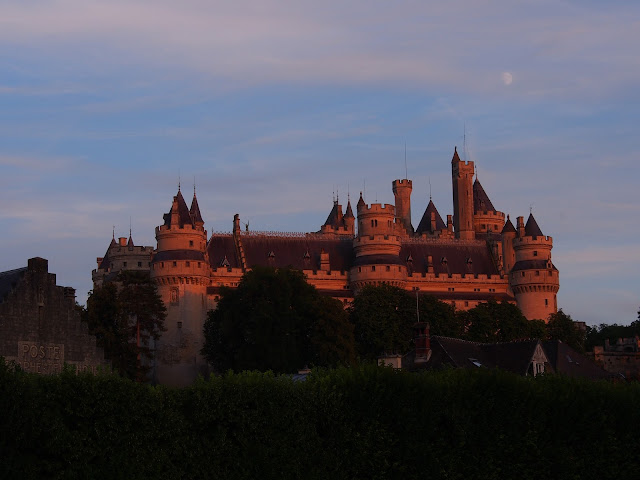 |
| Sunset that night |
That night I sat in the main square eating while I alternated people watching and reading. I had found out that surprise surprise the bus from Pierrefonds to Compiègne only ran two days a week in August. So I decided to walk to Compiègne early the next day and catch a blablacar from there to Reims. The road I walked was straight on one of the geometric hunting roads through the forest of Compiègne (I showed a picture of it earlier). It was only 14 km, and I had just made it about half the way before a friendly driver offered me a ride the rest of the way.
I had several hours to wait before my ride left, so I spent them lounging in the château's gardens enjoying the sun and carefree lovers and families outside, all of us enjoying the grand remnants of the French monarchy. After arriving in Reims, I washed my clothes and readied myself for the next leg of my journey. After a week, I was surprisingly ready to begin walking again.
Until next time...
 |
| One more Joan of Arc statue in Compiègne |




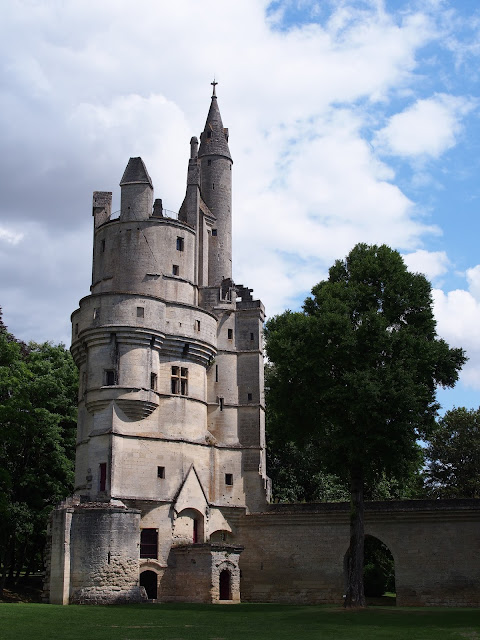








































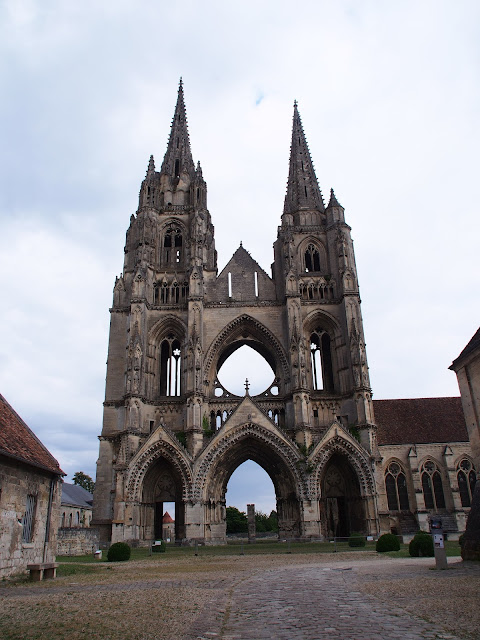























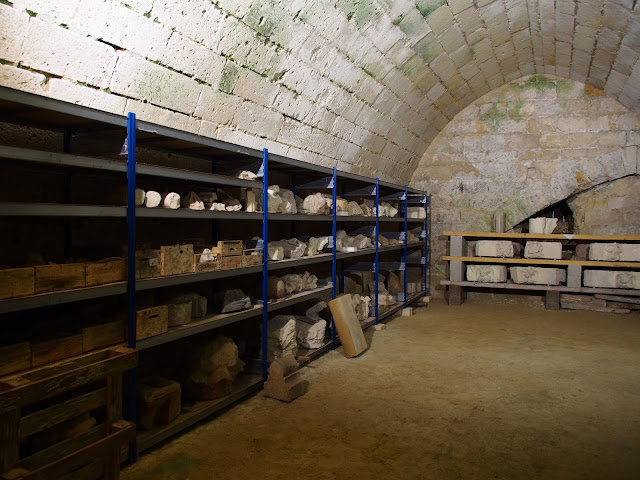









































































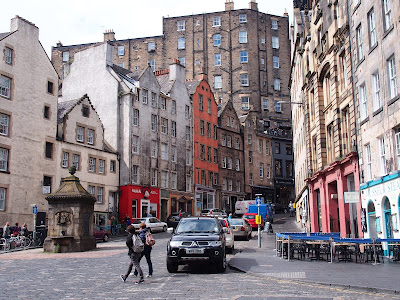
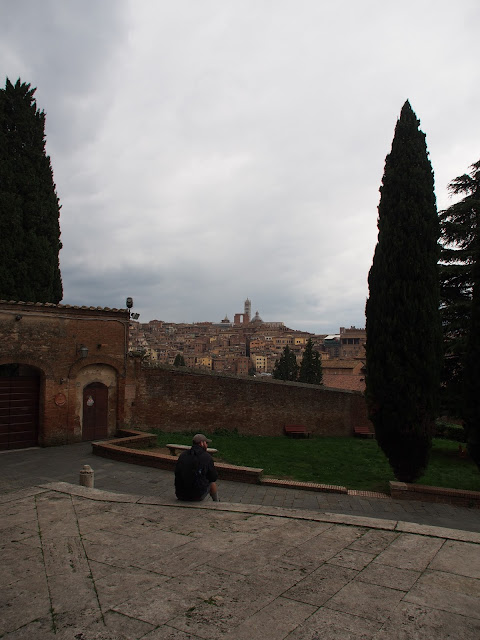

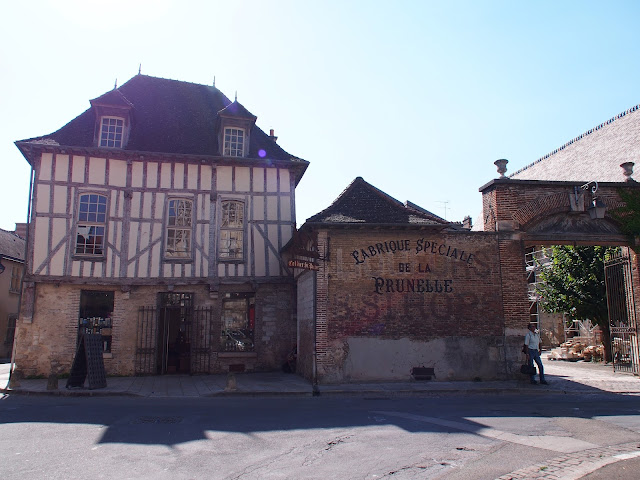



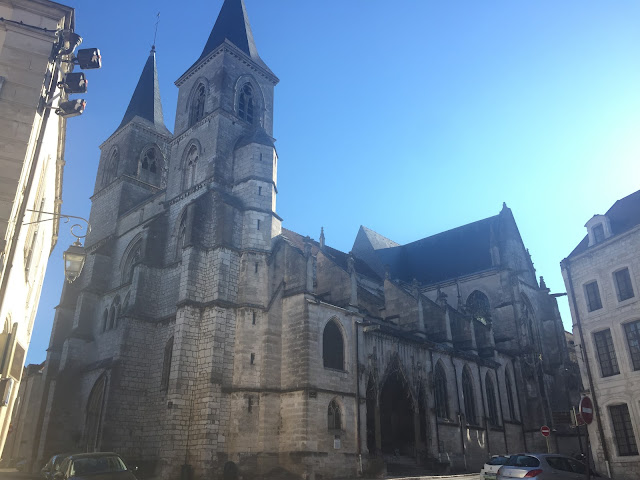
Comments
Post a Comment